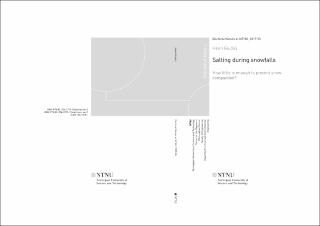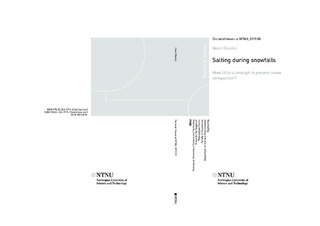| dc.contributor.advisor | Klein-Paste, Alex | |
| dc.contributor.advisor | Alvarez, Nuria Espallargas | |
| dc.contributor.advisor | Wåhlin, Johan Olof | |
| dc.contributor.author | Giudici, Henri | |
| dc.date.accessioned | 2019-03-08T12:38:25Z | |
| dc.date.available | 2019-03-08T12:38:25Z | |
| dc.date.issued | 2019 | |
| dc.identifier.isbn | 978-82-326-3715-7 | |
| dc.identifier.issn | 1503-8181 | |
| dc.identifier.uri | http://hdl.handle.net/11250/2589390 | |
| dc.description.abstract | During snowfalls, snow fallen on roads gets compact by traffic and can form an extremely slippery and dangerous road surface. The objective of winter maintenance operations is to ensure road mobility and traffic safety. Typical winter maintenance operations during snow falls are mechanical removal of snow (snow plowing) and altering the snow by the use of de-icers. The most commonly used de-icer is the sodium chloride (NaCl). The use of NaCl is economically demanding as well as detrimental for water and vegetation lying alongside the road surface. In recent years in Norway, more than 250,000 metric cubic tons of NaCl have been applied on roads during winter time. Therefore, there is a growing desire among road agencies to optimize the use of salt on roads without compromising traffic safety. To accomplish this goal, more knowledge is required on the influence of NaCl on the mechanical properties of snow. The focus of this thesis is on the optimization of salt in order to prevent snow compaction during snowfalls. In order to optimize the amount of NaCl used during snowfalls, the way salt affects snow and tire-pavement interaction must be better understood. More specifically, the minimum amount of salt that is needed to bring snow in a weak, cohesionless state is still to be determined.
To my knowledge, the application of salt is mainly based on the experience of winter maintenance personnel and not scientifically based. Therefore there is a need for more knowledge on salted snow and its behavior during mechanical actions.
With indoor and outdoor studies, this thesis aimed to understand the behavior of salted snow under the effect of tire compression and explored applicability of this knowlegde in realistic conditions.The behavioral understanding of snow mixed with diluted NaCl aqueous solution provided in this thesis are:
·For a given load, the snow containing NaCl solution gets compressed to a higher density, compared to snow without NaCl solution. A solution content of 10 wt.% inside the snow increased the density of the snow crystals with up to 30%, compared to pure snow. Beyond 10 wt.% solution content, the density of the compressed snow does not increase but it flattens out.
·Despite the higher density, the presence of NaCl aqueous solution weaken the compressed snow. An solution content of 5wt.% - 10 wt.% is able to substantially reduce the strength of ice in grain-grain contact, such that snow is easily removed mechanical action.
·During the mechanical compression, the presence of NaCl solution increased significantly the flowability of the snow. With 10 wt.% solution content the amount of snow that was squeezed out of the contact area of a rolling test tire (7.2 km/h) increased by more than 50 %, compared to pure snow. Further increase in solution content (up to 40 wt.%) does only slightly increase the squeeze out.
·The field investigation suggest that a solution content of 5-10 wt.% (diluted) NaCl solution is enough to prevent compacted snow formation. 10 wt.% was enough to get the snow removed by the effect of 20 vehicle passes, whereas 5 wt.% was enough to remove the snow by a scraping blade. These estimates are considered conservative as they were obtained under conditions of that create most severe snow compaction (slow driving, close to 0°C).
·The minimum amount of salt (in g/m2) is calculated for a given snow fall, using the criterion of 5 and 10 wt.% NaCl solution content. To determine an actual application rate, a safety factor remains to be determined to account for salt loss during and after spreading. | nb_NO |
| dc.language.iso | eng | nb_NO |
| dc.publisher | NTNU | nb_NO |
| dc.relation.ispartofseries | Doctoral theses at NTNU;2019:55 | |
| dc.relation.haspart | Paper 1: Giudici, Henri; Wåhlin, Johan; Klein-Paste, Alex. Uniaxial compression on salted snow. Tire Science and Technology 2018 ;Volum 46.(1) s. 16-26
Is not included due to copyright
available at
https://doi.org/10.2346/tire.18.460104 | nb_NO |
| dc.relation.haspart | Paper 2; Tire-pavement interaction in contact with presence of salted snow: How an aqueous solution affects the compression, squeeze out and compaction of snow
- This material may be downloaded for personal use only. Any other use requires prior permission of the American Society of Civil Engineers. This material may be found at https://doi.org/(ASCE)CR.1943-5495.0000192 | nb_NO |
| dc.relation.haspart | Paper 3: Giudici, Henri; Fenre, Mathis Dahl; Rekilä, Katja-Pauliina; Klein-Paste, Alex. A Technical Description of LARS and Lumi: Two Apparatus for Studying Tire-Pavement Interactions. Routes/Roads Magazine 2017 (375) Suppl. 4 s. 49-54 | nb_NO |
| dc.relation.haspart | Paper 4: The influence of aqueous solution on compacted snow: a field investigaton.
This material may be downloaded for personal use only. Any other use requires prior permission of the American Society of Civil Engineers. This material may be found at
https://doi.org/10.1061/(ASCE)CR.1943-5495.0000195 | nb_NO |
| dc.title | Salting during snowfalls - how little is enough to prevent snow compaction? | nb_NO |
| dc.type | Doctoral thesis | nb_NO |
| dc.subject.nsi | VDP::Technology: 500::Environmental engineering: 610 | nb_NO |

